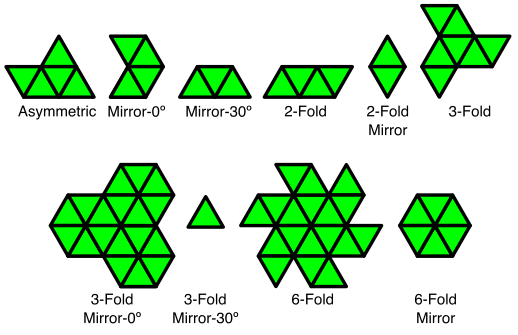Polyiamond
| Wikimedia Commons has media related to Polyiamonds. |
A polyiamond (also polyamond or simply iamond) is a polyform whose base form is an equilateral triangle. The word polyiamond is a back-formation from diamond, because this word is often used to describe the shape of a pair of equilateral triangles placed base to base, and the initial 'di-' looks like a Greek prefix meaning 'two-' (though diamond actually derives from Greek adamant). The name was suggested by recreational mathematics writer Thomas H. O'Beirne in New Scientist 1961 number 1, page 164.
Counting
The basic combinatorial question is, How many different polyiamonds exist with a given number of cells? Like polyominoes, polyiamonds may be either free or one-sided. Free polyiamonds are invariant under reflection as well as translation and rotation. One-sided polyiamonds distinguish reflections.
The number of free n-iamonds for n = 1, 2, 3, … is:
The number of free polyiamonds with holes is given by ![]() A070764; the number of free polyiamonds without holes is given by
A070764; the number of free polyiamonds without holes is given by ![]() A070765; the number of fixed polyiamonds is given by
A070765; the number of fixed polyiamonds is given by ![]() A001420; the number of one-sided polyiamonds is given by
A001420; the number of one-sided polyiamonds is given by ![]() A006534.
A006534.
| Name | Number of forms | Forms | ||||||||||||
|---|---|---|---|---|---|---|---|---|---|---|---|---|---|---|
| Moniamond | 1 |
| ||||||||||||
| Diamond | 1 |
| ||||||||||||
| Triamond | 1 |
| ||||||||||||
| Tetriamond | 3 |
| ||||||||||||
| Pentiamond | 4 |
| ||||||||||||
| Hexiamond | 12 |
| ||||||||||||
Symmetries
Possible symmetries are mirror symmetry, 2-, 3-, and 6-fold rotational symmetry, and each combined with mirror symmetry.
2-fold rotational symmetry with and without mirror symmetry requires at least 2 and 4 triangles, respectively. 6-fold rotational symmetry with and without mirror symmetry requires at least 6 and 18 triangles, respectively. Asymmetry requires at least 5 triangles. 3-fold rotational symmetry without mirror symmetry requires at least 7 triangles.
In the case of only mirror symmetry we can distinguish having the symmetry axis aligned with the grid or rotated 30° (requires at least 4 and 3 triangles, respectively); ditto for 3-fold rotational symmetry, combined with mirror symmetry (requires at least 18 and 1 triangles, respectively).

Generalizations
Like polyominoes, but unlike polyhexes, polyiamonds have three-dimensional counterparts, formed by aggregating tetrahedra. However, polytetrahedra do not tile 3-space in the way polyiamonds can tile 2-space.
Tessellations
Every polyiamond of order 6 or less tiles the plane. All but one of the heptiamonds tile the plane.[1]
Correspondence with polyhexes

Every polyiamond corresponds to a polyhex, as illustrated at right. Conversely, every polyhex is also a polyiamond, because each hexagonal cell of a polyhex is the union of six adjacent equilateral triangles. (Note, however, that neither correspondence is one-to-one.)
See also
External links
- Polyiamonds at The Poly Pages. Polyiamond tilings.
- VERHEXT — a 1960s puzzle game by Heinz Haber based on hexiamonds (Archived March 3, 2016, at the Wayback Machine.)
